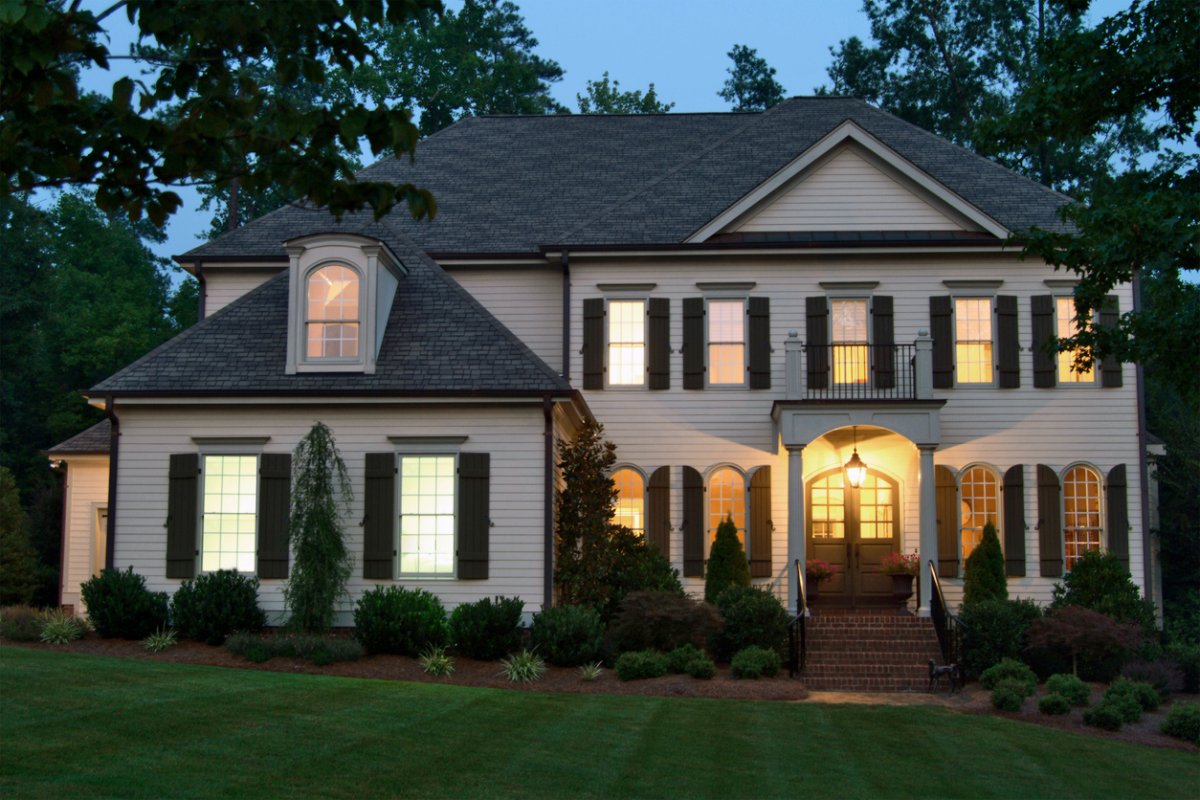

We may earn revenue from the products available on this page and participate in affiliate programs. Learn More ›
Q: We’ve just moved to a new neighborhood. When we lived in our previous home, everyone on the street left their porch lights on all night long, but in this neighborhood most homes have the light off by the time everyone goes to bed. Should you leave your porch light on at night? Is there a safety benefit to leaving it on, or is there a reason not to?
A: A bright porch light has often been regarded as a beacon of welcome, inviting residents and guests into the warm embrace of home after a long day at work or travel. In some cases, a porch light is also used as decorative porch lighting to communicate support for a group or cause; for example, a green porch light shows support for veterans. Flicking a porch light on and off can signal to neighbors that there’s a problem and the home’s residents need help—a flashing porch light certainly draws attention. But are porch lights really safety devices, and should you leave your porch light on at night?
You’ve asked a great question because conventional wisdom says that the more lighting a home has outside, the less likely it is that an intruder will choose that home to break into—it’s often at the top of the list of home security tips. And in many cases, this is correct! Also, every neighborhood has its own habits and tendencies, so the fact that your new neighbors turn their outdoor porch lights off early while on other streets neighbors leave lights on all night doesn’t necessarily mean there’s a problem—it could just be that in the past there was an issue with neighbors shining lights into other people’s windows by accident and everyone is being courteous. Conversely, it might be that most of the neighbors have been in their homes for a long time and haven’t really given the porch light much thought. Porch lights certainly contribute to the overall safety of the front entryway, but there are some things to consider when deciding if it should be the primary safety device overnight. Surprisingly, leaving a porch light on all night not only uses excess electricity, but in some cases, it can backfire and actually reduce the security of the home.
Leaving the porch light on in the evening can let potential intruders know someone is home, but leaving it on overnight or while you’re on vacation signals to burglars that no one is home.
Potential intruders look for signs and patterns. In the evening, a dark home with no lights on outside or inside looks empty—which translates into a good target for a burglary. Especially now that many homes have security systems integrated into smart-home systems that would automatically illuminate interior and exterior lights at dusk, a dark porch light could signify that nobody is home and that the home is not secured in other ways. Because of this, turning on the light at dusk, either manually, using a timer, a smart system, or even a light-sensing timer, is a good idea.
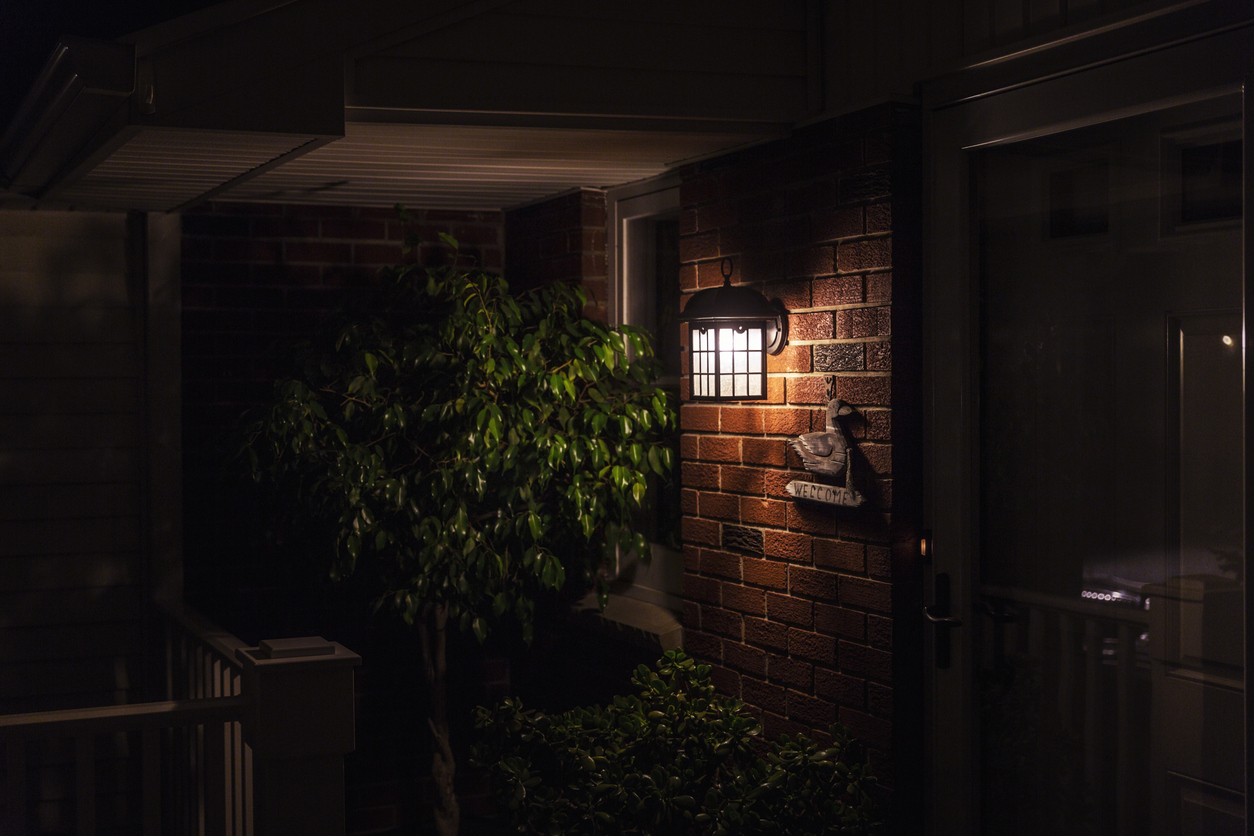
As noted, however, criminals look for patterns. If a home’s interior lights don’t turn on, but the porch light flashes on reliably at 6 p.m. and turns off at precisely 11:30 p.m. every night with no indication of movement inside the home, the automatic porch light can signify that the home’s residents are away, again making the home a target. Residents planning to use a timer for their porch light while on vacation will want to include other devices to give the home a lived-in appearance, including lights on various timers inside. Similarly, if the porch light usually turns off at 11:30 p.m. and it’s suddenly left on all day and all night for a week, this creates a risk: even unobservant criminals will know that the owners are likely away.
What about the all-night porch light? Whether or not this increases safety is a toss-up. If a home’s residents always leave the light on all night and turn it off at dawn, it’s probably not going to affect the home’s vulnerability in one direction or another. However, if the pattern changes—the light that usually turns off promptly at 11:30 p.m. is left on all night only when one car is missing from the driveway, or only on Thursdays (when one resident works the night shift), that light can communicate that the person in the home feels unusually vulnerable for a reason, and it could encourage a would-be burglar to take action.
It’s a good idea to leave the porch light on if you’re expecting a nighttime delivery or if a resident is expected home late at night.
When a home’s residents plan to arrive home after dark, leaving front house lights on is a standard safety procedure. Even if porch lights with sensor activation are engaged, it’s troubling to approach a front door without being able to take in the surroundings until a bright light flashes on in the dark. There is something residents will want to be careful about when keeping lights on for late arrivals, however: It’s best not to highlight which entry will be used by someone returning home at night. For example, if the family normally uses the back door to enter the home, leaving a light on there makes sense—but it’s also a good idea to leave the front porch lighting on as well until everyone is in for the night. Turning off all other lights except for a back-door light signals that someone will be approaching that particular door, potentially alone or after everyone else in the home is asleep, and this could create a situation where a criminal chooses to exploit that vulnerability. Similarly, if the front entry is where residents expect to enter, it’s a good idea to also leave the back porch lights on until everyone’s home. Leaving the lights on at each entry until the residents are safely home can prevent that type of targeting. If the back-door entrance isn’t wired for lighting, residents may consider adding a solar or wireless porch light for this extra layer of security.
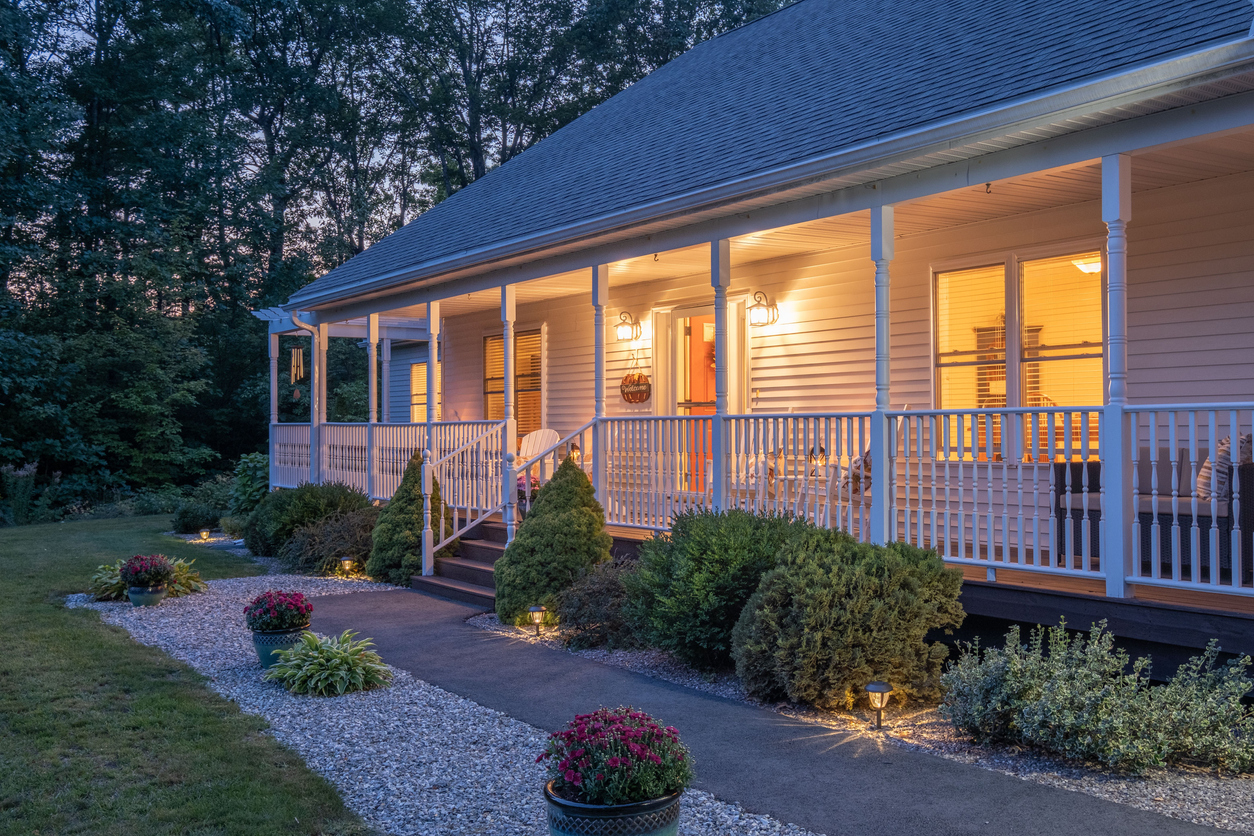
It’s always safer for invited or wanted guests to approach a home in a well-lit situation, so if a delivery update has announced that a package will be delivered after dark, residents may want to consider leaving the light on for the delivery person. They will more easily find the home and will be more comfortable approaching the step if the light is on, and the home’s residents will be less likely to be surprised or nervous about a person approaching the home when they can clearly see who the person is.
If you live in a rural area, leaving your porch light on at night can make it less challenging for intruders to break into your home, as they can easily see what they are doing.
There are some situations where less lighting is beneficial, and one of those is when a home is located in a rural area without any close neighbors. Always-on bright lighting may help residents feel safer because it illuminates the surroundings and immediately draws attention to anyone approaching the home, but there are two problems with that thought process. First, nobody can remain awake all the time, and it’s only helpful to highlight an approaching person or vehicle if there’s someone awake to notice the approach. Second, if the home’s residents are not closely watching every minute (for example, when they’re not home or when they’re sleeping), the extra lighting can help criminals more effectively approach and gain entry to the home—no need to use flashlights when the exterior is brightly lit and there are few (or no) neighbors to notice their actions. In this case, a motion-sensor porch light with security camera connection (preferably attached to a security or alarm system) is a better approach than simply brightening the space all the time.
A home on a well-lit street is less likely to be broken into than a home on a dark street.
Generally, criminals prefer darkness. It’s easier for neighbors or passersby to observe movements or actions that may seem suspicious when an area is well lit, and in a neighborhood where many houses have exterior lighting, there aren’t as many dark corners from which criminals can make a plan or slide up to an entrance unobserved. In addition, a brightly lit street suggests that neighbors are watching out for each other and working together to enhance the safety of their neighborhood. This, of course, doesn’t mean that no crime occurs on streets with good lighting, but such streets are less hospitable to intruders than streets with more shadows. Taking part in a neighborhood watch or speaking to neighbors about a more comprehensive or consistent approach to outdoor lighting can make the street safer in many ways.
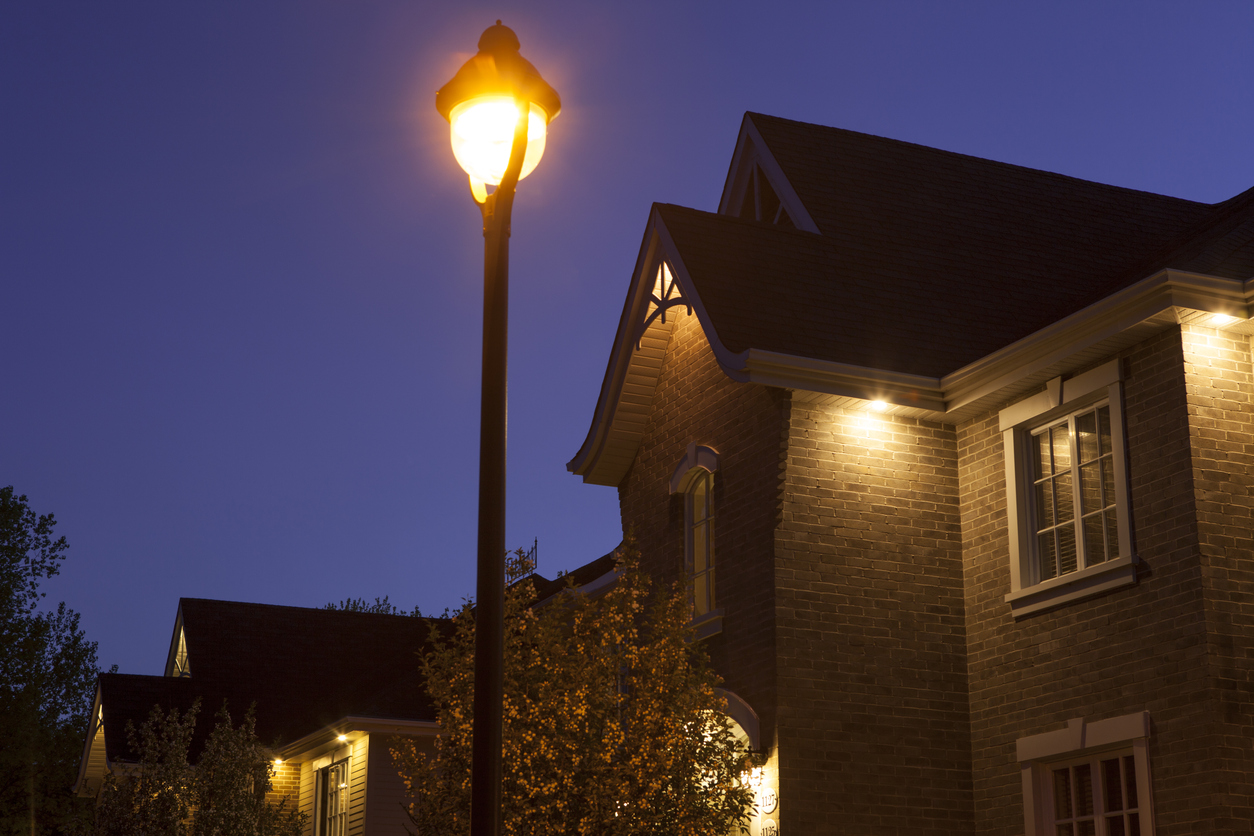
Living in a tight-knit community can provide additional home security, as neighbors can watch out for each other and ward off potential intruders.
Neighborhoods where residents look out for one another’s safety by keeping an eye on one another’s homes when people are on vacation, pulling packages off one another’s doorsteps when they’re not home and securing them, and checking in on older or vulnerable neighbors are generally more secure overall. A greater number of watchful eyes are more likely to notice something out of place and alert others on the street, whether it’s an unfamiliar car parked in front of an unoccupied home or a bear wandering through the backyards. Making friends with neighbors is a great way for residents to enhance their home’s front-door security.
It’s generally a better deterrent to install a motion-security light that turns on when it detects movement than to leave a porch light on at night.
When the home’s residents are still awake or awaiting the arrival of a person or a package, it makes sense to leave the porch light shining consistently. Other than that, motion-activated security lighting is a more effective way to light the area for unexpected (or unwelcome) guests. Why? A static light creates expected pockets of light and darkness, allowing a potential criminal to plan their approach in a way that won’t draw attention to their actions. When motion-activated lights flash on, they are more likely to draw the attention of a neighbor or passerby, and if they’ve been activated by someone snooping around the home, the potential intruder will be forced to either find a way to act as though they belong or depart quickly. Knowing the motion-sensor lights are in place will essentially turn the home’s perimeter into a minefield for a criminal—they won’t know where it’s safe to walk and where they’ll trigger another light to flash on. Although a single illumination of a motion light may not draw a lot of attention, repeated flashing on and off most certainly will, so the lighting system becomes an active deterrent to a criminal.
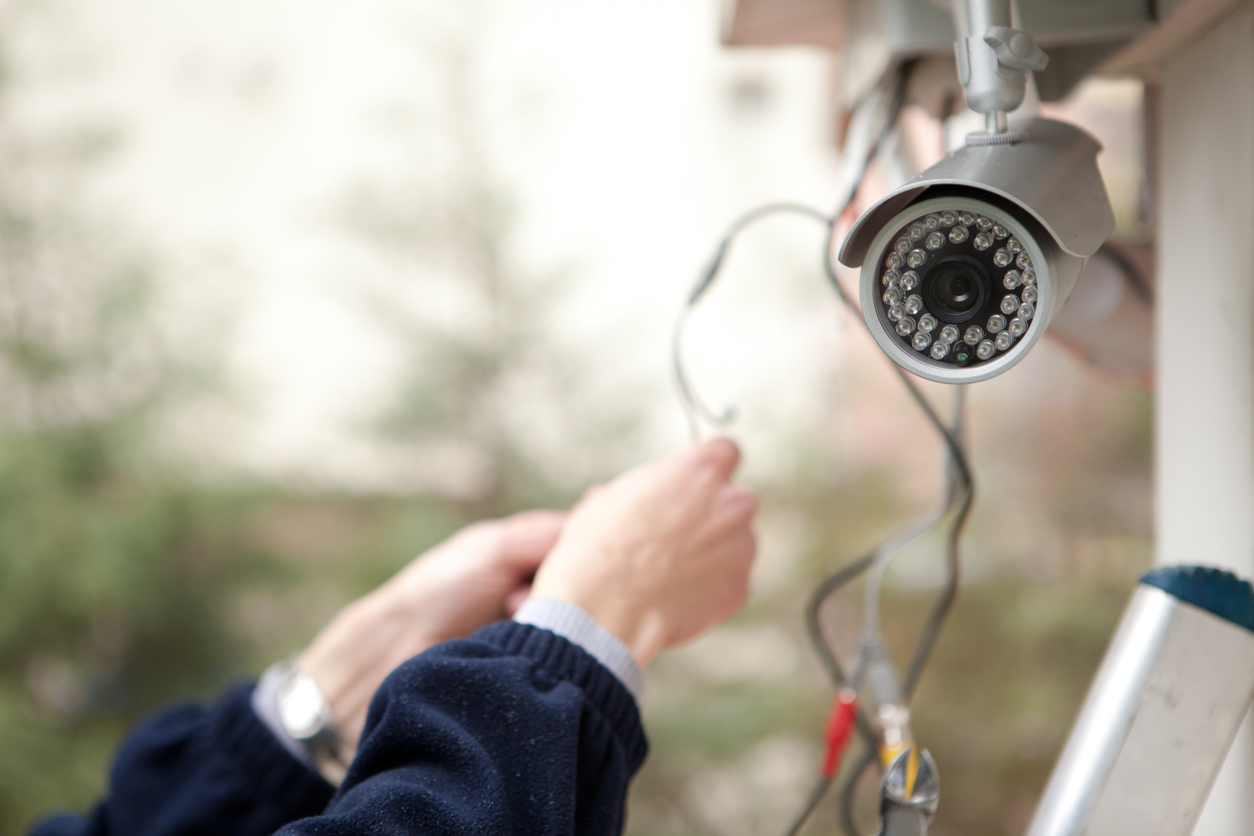
A comprehensive home security system that includes exterior lighting and cameras is the best way to protect your home from intruders.
Turning on a porch light when it gets dark in a neighborhood where most people do so or when it’s anticipated that residents will be returning after dark is a great first step toward home security. However, a blended or layered approach to home security can greatly increase the safety of a home and its residents. A home security system is well worth the cost if it helps prevent crime or provides added peace of mind to residents.
A static porch light during the evening hours is a baseline. Adding motion-sensor lighting that activates anytime there’s movement within the sensor’s field is a great next step, and a comprehensive plan for static and motion-based exterior illumination is an even better plan. This can include the best outdoor solar lights that increase the eco-consciousness of the system and provide consistent low-lighting of the property, the best outdoor light bulbs in fixtures at entry points or dark areas triggered by motion sensors, and other backyard lighting ideas that make approaching the entry points more secure. The final step that adds the greatest level of security is incorporating lighting into a security system that includes cameras and entryway sensors; residents will want to consider using one of the best home security companies (such as Vivint, ADT, or SimpliSafe) for their system. This goes for renters, too: While renters can hope that their landlord or property management company is on top of security measures such as exterior and hallway lighting, that’s not always the case, but one of the best apartment security systems can add this extra layer of security to rented homes as well. This approach maximizes the technology available to secure a home, giving the residents complete control (often from a mobile app) and makes the residents feel secure without turning the home into a fortress.
